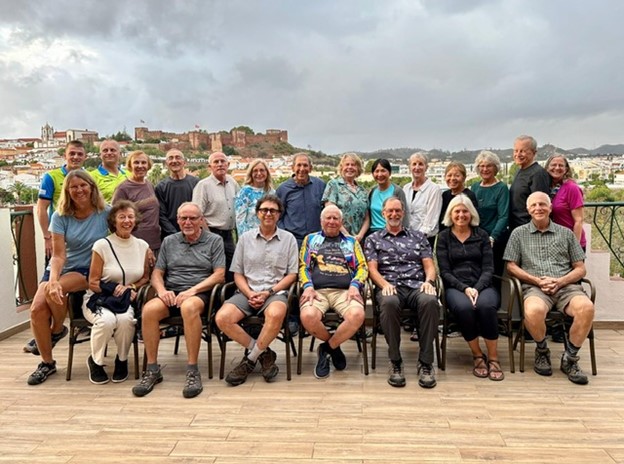The Bicycle Adventure Club - Come Ride With Us!
Ride Ratings (short guide)
Climbing LevelLevel 1 – Up to 1500 ft
Level 2 – 1500 to 2500 ft
Level 3 – 2500 to 3500 ft
Level 4 – More than 3500 ft
Distance Level
Level A – Up to 35 mi
Level B – 35 to 50 mi
Level C – 50 to 65 mi
Level D – More than 65 miles
More detailed descriptions can be found on the Ride Rating System page
Southern Portugal 2024
October 4th to October 20th
Ride Coordinator: Sue Bunten
Report by: Alice Carter
Portugal has a fascinating history. In the past it was occupied by the Romans and later the Moors. It was a world super-power with colonies all over the globe thanks to the intrepid naval explorers sailing on their caravels in the 14th and 15th centuries, yet it also has a darker history as the home of the first slave market in Europe and a major participant during the Inquisition. Today, most of its population lives in Lisbon and Porto, and the rural towns are slowly crumbling amid the vineyards and orchards of cork and olive trees.
We learned this while riding on the inaugural BAC Southern Portugal tour which took us through the Alentejo and Algarve regions. Starting in Évora, we spent a few days rolling through rural terrain surrounded by cork trees and enjoying views of hilltop castle remains before returning to Évora for a day off. Surprising finds in this area included a prickly pear cactus farm and towns with marble sidewalks and curbs. Évora, a UNESCO world heritage city, featured a Roman temple, medieval walls, a fortress-like cathedral, an aqueduct, and the memorable and unusually decorated Chapel of Bones.
Leaving Évora we headed southwest toward the coast and eventually rolled into the Algarve region, going all the way to Sagres, the southwestern most part of the continent--what was once thought to be the edge of the world! We then turned east and occasionally visited the coast again but spent much of the ride inland, including riding through orange groves and heading up into the Serra da Monchique. The backdrop of our group photo shows the castle in Silves, the Moorish capital of the Algarve. We then rolled down to the coast at Tavira where our journey ended.
Rain discouraged us from exploring as much as we might have, but it spared us from the usual intense heat of the south. Despite the rain we enjoyed seeing the white-washed towns with their blue or yellow trim around doors and windows, colorful wall tiles used as both interior and exterior decoration, and fancy chimneys on the houses in the Algarve. We spotted stork nests perched up high and dramatic coastlines at Porto Covo and Sagres. Memorable stops included visiting museums filled with painted tiles (Estremoz) and hand-woven rugs (Arraiolos), watching a potter create beautiful bowls (Redondo), and peeking into a cork factory to see it at different stages of processing (Azuruja). Many of us got off the saddle to shop at the local markets, watch an artist paint a large mural, get a massage, or take a boat ride in the Atlantic. We dined on olives, bread dipped in olive oil, a variety of cream soups, cod and other seafood, and enjoyed local drinks including wine, beer, and the memorable ginjinha, port, and sangria. The terrain was rolling with some steep climbs and some long ones, but there were no significant mountain passes. Most of the routes were on quiet backroads although we picked up some traffic on the roads along the coast.
This trip was led by Sue Bunten in cooperation with the tour company Sitnica. Alen Augustin from Sitnica rode with us each day while his nephew Luca drove the van and handled the luggage. Alen’s daughter Nicole spent the first week with us while she was on a school break. These leaders helped participants discover the beauty in southern Portugal.
Bicycle Adventure Club
PO BOX 23998 San Diego, CA 92193
Telephone (858) 715-9510 office@bicycleadventureclub.org
